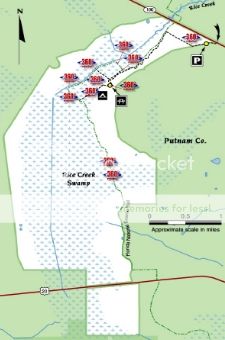Wild Rice Multi-Cache
MysticCache: Permit expired...
-
Difficulty:
-

-
Terrain:
-

Size:  (large)
(large)
Please note Use of geocaching.com services is subject to the terms and conditions
in our disclaimer.
Rice Creek Conservation Area - A friendly multi-cache highlighting this exciting conservation area. The Florida Trail is just another 1000 feet from the final cache location. –---- Congratulations to the Federation for FTF!!!
Size: 5,061 acres. Along Rice Creek Swamp, extending south from State Road (SR) 100 to just south of SR 20 in Putnam County, approximately six miles west of Palatka.
Through passage of the Water Resources Act (Chapter 373, Florida Statutes), the water management districts were created in 1972 for this purpose. In northeast and east-central Florida, that responsibility falls to the St. Johns River Water Management District.
District officials recognize the need to have water resources available for people’s needs and to balance those needs with nature’s needs. In its daily operations, the District tries to strike a balance in water needs by educating the public about water conservation, setting rules for water use, conducting research, collecting data, managing land, restoring and protecting water above and below the ground, and preserving natural areas.
If nature is your thing, consider visiting some of the scenic and unspoiled 700,000 acres of land owned by the St. Johns River Water Management District.
With funds from the state’s Florida Forever program and through partnerships with state and local governments and nonprofit groups, the District purchases and manages tracts of land that are important in protecting our water resources, keeping the land in its natural state. The land helps to filter out pollutants from runoff, prevent erosion and provide flood protection, and it serves as protected plant and animal habitat.
Chances are you live somewhere near a District-owned site. These properties range from wetlands and historically wet areas to dry upland areas suitable for a variety of outdoor activities. Virtually all District properties are open to the public.
So what can you do on District lands?
• Take a hike. Ramble your way through miles of trails and you’re bound to spot some of the abundant wildlife that thrive on these protected lands.
•Make a splash. Some District properties offer opportunities for canoeing, air boating and boating, and a few even have boat ramps or launches.
•Go fish. District land is home to some great fishing. Some properties include handicapped-accessible fishing platforms, while other areas are best fished from the bank or from a canoe or small boat.
•Ride along. The majority of District lands provide trails that are suitable for cycling or horseback riding. A ride through one of our properties is a great way to see a diverse range of natural areas and wildlife.
•Sleep out. For the hardcore outdoorsman, some District lands provide opportunities for primitive tent camping. If you are willing to forego bathrooms and running water for a day or two, you can have the full outdoor experience, complete with a crackling campfire under the stars.
•Go hunting. Approximately two-thirds of District land is open for hunting, in designated areas and at specified times of the year.

Rice Creek Swamp covers approximately 70 percent of the property. Together with Palmetto Branch, Oldtown Branch and Hickory Branch — which are all just west of the conservation area — the swamp forms the headwaters of Rice Creek, a large tributary of the St. Johns River. The area was an indigo and rice plantation during the 18th century, and most of the uplands were managed as commercial pine plantations before District ownership. The site has a variety of natural communities, including floodplain swamp, flatwoods, dome swamp, floodplain forest and upland mixed forest. The area is also a key parcel for connecting Etoniah State Forest to the Cross Florida Greenway.
Wildlife viewing:
The area serves as a wildlife corridor, connecting several large natural areas. Natural community diversity supports Florida black bear, white-tailed deer, turkey, river otter, wood duck and diverse migratory songbirds.
Additional Hints
(Decrypt)
Fahttyrq nzbat gur ebjf naq gur zbhaqf jurer gur cvarf jrer uneirfgrq. JNGPU LBHE FGRCF.